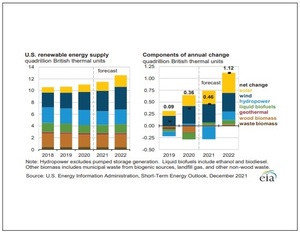EIA updates bioenergy production, capacity forecasts
By Erin Voegele | December 07, 2021
Renewables are currently expected to account for 22 percent of U.S. electricity generation in 2022, up from 20 percent in 2021, according to the U.S. Energy Information Administration’s latest Short-Term Energy Outlook, released Dec. 7.
The electric power sector is expected to generate 27.6 billion kilowatt hours (kWh) of electricity from biomass this year, including 15.6 billion kWh from waste biomass and 12 billion kWh from wood biomass. Biomass generation is expected to fall to 26.2 billion kWh in 2022, including 15.4 billion kWh from waste biomass and 10.8 billion kWh from wood biomass. Biomass generation was at 26.8 billion kWh in 2020, including 15.6 billion kWh from waste biomass and 11.2 billion kWh from wood biomass.
Across other sectors, biomass generation is expected to reach 27.7 billion kWh this year, including 2.7 billion kWh from waste biomass and 24.9 billion kWh from wood biomass. Those levels of generation are expected to be maintained through 2022. Biomass generation was at 27.9 billion kWh in 2020, including 2.9 billion kWh from waste biomass and 25 billion kWh from wood biomass.
The electric power sector is expected to consume 0.234 quadrillion Btu (quad) of waste biomass in 2022, down from both 0.237 quad in 2021 and 0.242 quad in 2020. The sector is also expected to consume 0.174 quad of wood biomass next year, down from 0.192 quad in 2022 and 0.185 quad in 2020.
The industrial sector is expected to consume 0.1546 quad of waste biomass this year, flat with 2020. Consumption of waste biomass is expected to fall slightly to 0.154 quad in 2022. The sector also consumed 1.376 quad of wood biomass last year, with consumption expected to increase to 1.397 quad in 2021 and 1.44 quad in 2022.
The commercial sector is expected to consume 0.035 quad of waste biomass in both 2021 and 2022, down from 0.036 quad in 2020. The sector is also expected to consume 0.082 quad of wood biomass this year and next year, down from 0.083 quad in 2022.
The residential sector is expected to consume 0.455 quad of wood biomass in 2021 and 2022, down from 0.458 quad last year.
Across all sectors, the consumption of wood biomass is expected to reach 0.424 quad in 2021 and 0.423 quad in 2022, compared to 0.43 quad in 2020. Wood biomass consumption was at 2.101 quad in 2020 and is expected to increase to 2.121 quad in 2021 and 2.151 quad in 2022.
The electric power sector is currently expected to have 6,154 megawatts (MW) of biomass power capacity in place by the end of this year, including 3,793 MW of waste biomass capacity and 2,362 MW of wood biomass capacity. Biomass capacity is expected to increase to 6,190 MW by the end of 2022, including 3,829 MW of waste biomass capacity and 2,362 MW of wood biomass capacity. The sector’s biomass generating capacity was at 6,295 MW at the end of 2020, including 3,790 MW of waste biomass capacity and 2,505 MW of wood biomass capacity.
Across other sectors, biomass capacity is expected to be at 6,289 MW at the end of 2021, including 778 MW of waste biomass capacity and 5,510 MW of wood biomass capacity. Biomass capacity is expected to fall to 6,281 MW by the end of next year, including 778 MW of waste biomass capacity and 5,503 MW of wood biomass capacity. Biomass capacity was at 6,302 MW at the end of 2020, including 777 MW of waste biomass capacity and 5,525 MW of wood biomass capacity.
